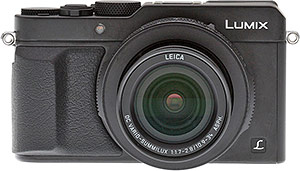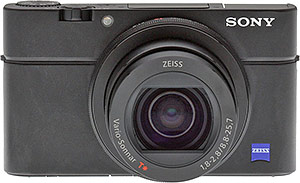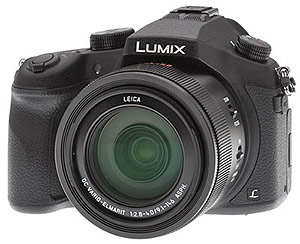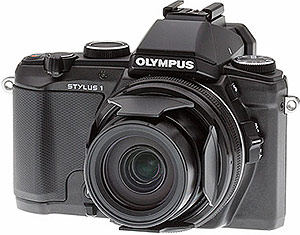The best camera under 1,000 dollars: Best compact camera
posted Monday, November 24, 2014 at 7:00 PM EDT
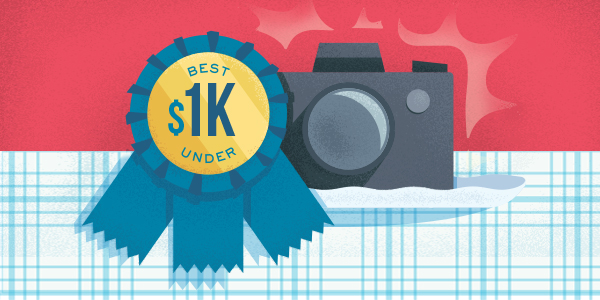
The competition has really been heating up for high-end compact cameras lately. (We're defining "compact" cameras here as ones with fixed, non-interchangeable lenses.) Nowadays, larger and larger sensors are getting squeezed into surprisingly compact camera bodies. This type of camera offers photographers the higher image quality of larger cameras, while still maintaining much smaller body sizes compared to most interchangeable lens models. If want a camera that you can literally drop in a jacket pocket, but don't want to give up image quality to do so, read on; we've got a couple of great selections for you!
Also garnering plenty of attention over the past few years have been the newer enthusiast zoom "bridge" cameras, which tend to be larger, to accommodate their long, bright (large maximum aperture) lenses, so we'll offer our views on a few choices options in that fixed lens category as well.
And for anyone who's yet to see our first two pages in this article there are links to each at the bottom of this page, or simply click here for best DSLR systems or best mirrorless systems for under $1000.
Options by Mike Tomkins, Dave Pardue and William Brawley
Best fixed lens camera
Panasonic LX100
Our choice for the best fixed-lens camera for under a grand is the new Panasonic LX100. At $899, you've still got some budget left over for accessories -- perhaps an extra battery or two or some memory cards? The LX100 uses a unique 12.8MP Four Thirds sensor that lets you shoot in multiple aspect ratios, and the high-quality Leica zoom lens provides a 24-75mm-equivalent range with a fast, variable aperture range of f/1.7-2.8 aperture, for lots of light-gathering ability and shallow depths of field. Like Panasonic’s recent high-end ILC the GH4, the new LX100 also incorporates Depth From Defocus technology in its contrast-detect AF system, for significantly faster autofocus.
The LX100 also packs in some advanced amenities and features, such as 4K video recording at both 30 and 24 frames per second (and 1080/60p video in multiple file formats), and built-in Wi-Fi and NFC connectivity. There's also a built-in EVF to provide easy composing and shooting in bright and dark lighting conditions as well as offering a more traditional and more stable shooting stance.
If you want the image quality of a Micro Four Thirds camera, but don't want the hassle of interchangeable lenses, and a camera that can still fit comfortably in a small bag or a jacket pocket, the Panasonic LX100 is that camera!
Compare
- Panasonic LX100 vs Sony RX100 III
- Panasonic LX100 vs Panasonic FZ1000
- Panasonic LX100 vs Olympus Stylus 1
Purchase:

Best premium compact that's pocketable
Sony RX100 III
It's been two and a half years since Sony launched the RX100, a revolutionary product that redefined what the pocket camera could be, and it has since honed the formula with the RX100 II and III. Of the group, the latter is our favorite for several reasons, key among them a brighter lens and a built-in electronic viewfinder. Only in the last few months has any direct competition for the RX100-series appeared.
Canon's G7X is the nearest rival, and like the RX100 III, it will slip nicely into a pants pocket. It bests the Sony with a very impressive lens that provides almost 50% greater reach, and yet is even brighter across much of the zoom range. The G7x is also faster-shooting when it counts -- with autofocus enabled -- adds a touch screen, and costs less to boot. So why, then, do we still favor the RX100 III?
Well, for one thing, we find the Sony RX100 III a little more comfortable in-hand than the G7X, whose controls feel a little cramped, by comparison. The RX100 III also has more versatile framing and review options, making it better-suited when shooting over the head or in bright sunlight. And while it doesn't have as much telephoto reach as the Canon, we found image quality a little better.
That's in part due to over-aggressive JPEG noise reduction in the G7X, and partly due to an occasional problem with lens flare in that camera. Add in a much more useful movie mode from the Sony, add in the fact that -- when similarly-configured -- its battery life is about 50% greater, and it seems to us that it's worth paying just a little more for the Sony RX100 III. Really, both of these are great cameras that you'll have a lot of fun shooting with, but we had just that little bit more fun roaming the streets with the Sony RX100 III.
Compare
- Sony RX100 III vs Panasonic LX100
- Sony RX100 III vs Panasonic FZ1000
- Sony RX100 III vs Olympus Stylus 1
Purchase:
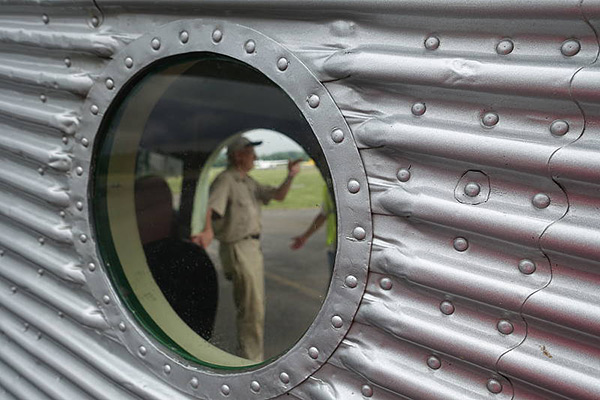
Best premium bridge camera
Panasonic FZ1000
If you're shopping for a premium bridge camera, there are two that should be right at the top of your list: the Sony RX10 and Panasonic FZ1000. In fact, given how much larger their sensor size than any competing bridge models, if you don’t mind their bulk, they’re a slam-dunk over smaller-sensored cameras, thanks to the increased image quality their larger chips offer. (If you want something pocketable, though, check out our recommendation for the Olympus Stylus One below.) Fortunately both of these cameras are under our $1,000 target, although the Sony only just squeaks through by the skin of its teeth.
We've had the opportunity to shoot quite extensively with both these cameras side-by-side, and we love them both, but for our money, there's a clear winner. The Panasonic FZ1000's lens might be a bit less bright across most of the zoom range, but it offers far more reach -- almost twice as much as that of the RX10, in fact. And yet the FZ1000 is barely any larger, weighs almost exactly the same, and is by some margin the more comfortable of the pair to shoot with. It doesn't quite exude the same build quality, but we just found ourselves wanting to reach for it more often than we did the Sony.
And that's not all. The Panasonic FZ1000 has a clear edge when it comes to performance, and we found its image quality the more pleasing of the pair -- in the daytime, at least. (At night, the Sony RX10 had the upper hand, so if you shoot a lot at night and can live without the telephoto reach, it might be the better bet for you.) Add in a much more capable Wi-Fi feature set that you'll almost certainly want to use more often -- helping get your photos online where friends and family can see them -- plus support for 4K video capture, and the Panasonic FZ1000 just strikes us as the better all-rounder.
And it certainly doesn't hurt that it's actually the more affordable of the pair, either! If you’re looking for a superb “bridge” camera with a sharp 16x zoom lens and 4K video chops, the Panasonic FZ1000 is the camera you’ve been waiting for!
Compare
- Panasonic FZ1000 vs Panasonic LX100
- Panasonic FZ1000 vs Sony RX100 III
- Panasonic FZ1000 vs Olympus Stylus 1
Purchase:

Olympus Stylus 1 + TCON-17x teleconverter
The Olympus Stylus 1 was first unveiled in the fall of 2013 and quickly garnered a coveted "Camera of Distinction" from us in our 2013 Camera of the Year awards, in the Enthusiast Zoom category, and for good reason. Today, a full year later, it remains a rare hybrid that marries a long zoom range, a bright maximum aperture when fully extended (f/2.8 all the way to 300mm eq. range), and a larger sensor than the traditional 1/2.3" sensor found in competing constant-aperture models like the Panasonic FZ200, yet is still compact enough to easily slip into a coat or vest pocket. Neither the FZ200 nor the 1" sensor bridge camera offerings from Sony (RX10) and Panasonic (FZ1000) can fit easily into a coat pocket, hence the rare appeal of the Stylus 1.
This camera also feels terrific in your hands, superbly built and a pleasure to use. (For much more on that, head over to our three in-depth Shooter's Reports!) And for anyone concerned that the 300mm eq. might be limiting, you're in luck, because the current street price for the camera of ~$650 leaves more than enough room to add the TCON-17X teleconverter, increasing your effective focal length range to 510mm eq, while still maintaining the fast f/2.8 max aperture! The combination is a really fun rig, and feels great in the hands. With the teleconverter attached, it gets a bit large for an average coat pocket, but that's the beauty of the teleconverter being removable. (To read our full review of the TCON-17X when paired with the Olympus Stylus 1, click here!)
But wait… we've still only spent about $890! The teleconverter sells for ~$200, and then you'll need the CLA-13 adapter in order to mount it on the Stylus 1, which is ~$40 more. This leaves ~$110 left over, and that's a lot of play money! Let's see… a spare battery for ~$40? Check. A 32GB class 10 SD card for ~$25? Check. $45 remaining for a cool camera bag and perhaps even a third battery? Why not! You've got an entire rig spanning an incredible 28-510mm eq. range at a constant f/2.8 aperture and are ready to go without so much as making that $1000 budget nervous.
As mentioned in our review, the one serious drawback is that the sensor is still less than half the size of those found in the larger 1" type bridge cameras mentioned above, and this does make a difference in low light shooting. However, since none of those larger-sensored models can achieve f/2.8 anywhere near the Stylus 1's telephoto reach with the teleconverter, the faster aperture largely balances the scales for low light shooting while zoomed out. And since zooming is the primary function for these cameras, it in many ways levels the playing field in the bridge camera arena for low light potential.
If you’re looking for a true all-in-one package that can fit into your coat pocket and travel with you anywhere, the Olympus Stylus 1 is an enormously appealing option. For compact, wide-aperture zoom reach, the Olympus Stylus 1 is truly hard to beat!
Compare:
- Olympus Stylus 1 vs Panasonic LX100
- Olympus Stylus 1 vs Sony RX100 III
- Olympus Stylus 1 vs Panasonic FZ1000
Purchase:


Conclusion
Thanks for reading! If you're in the market for a grea new camera, and are looking around the $1,000 price point, any of the dozen outfits we've profiled here will deliver the goods. We don't say this lightly; the advice we've given here is the result of literally hundreds of hours of testing in both the lab and the real world, and we leave no stone (nor sensor) unturned!
If this article or any of our other efforts here on this site have helped you decide which camera you're going to spend your hard-earned cash for, we'd appreciate it so much if you'd use one of the links we've provided above to make your actual purchase. Doing so doesn't cost you a dime, but makes a huge difference to us, helping to keep the informed, unbiased tests and opinions coming! Thank you!
Happy Holidays, and warm best wishes for many, many days of happy shooting!
(Note: Don't hesitate on these deals; some of them are tied to Black Friday/Cyber Monday holiday promotions, so may not last!)
Navigation
This page is one of three detailing our picks for the best camera packages under $1,000 in the 2014 holiday season. Click below, for our choices in the other two categories!
| The best camera setups under $1,000; Holiday 2014 edition |
| Best DSLR cameras for Holiday 2014 |
| Best Mirrorless cameras for Holiday 2014 |
| Best Compact cameras for Holiday 2014 (this page) |
| Shopping for a Superzoom? |
| The best Superzoom camera: Our 2014 Superzoom shootout |
| Shopping for Black Friday & Holiday Deals? |
| Imaging Resource Black Friday Camera Deals |
